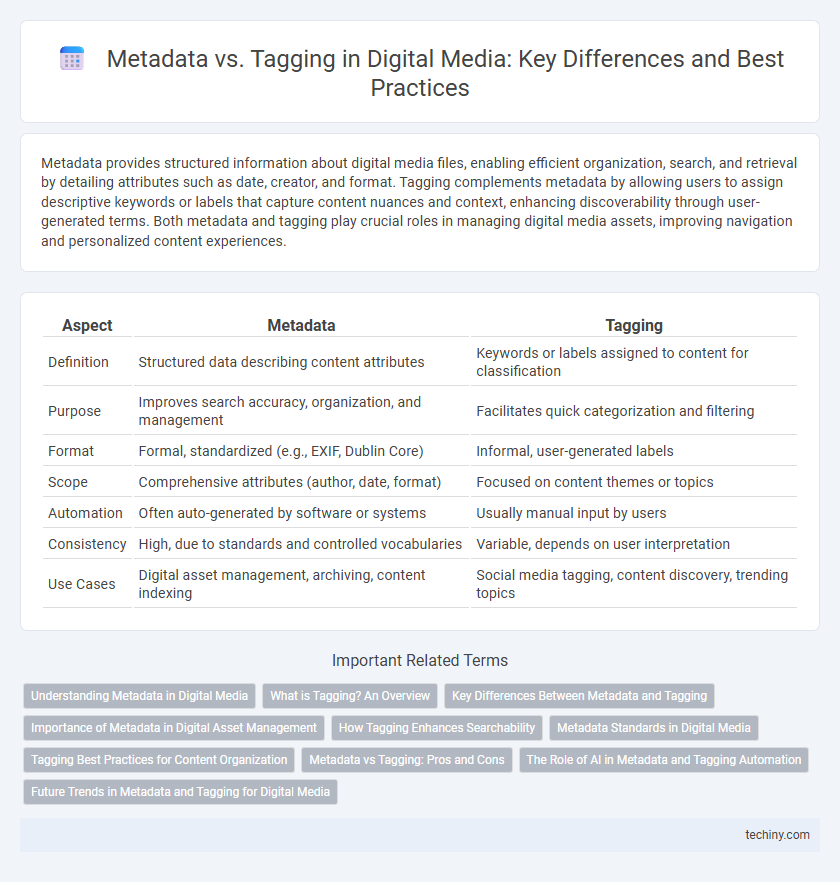Metadata provides structured information about digital media files, enabling efficient organization, search, and retrieval by detailing attributes such as date, creator, and format. Tagging complements metadata by allowing users to assign descriptive keywords or labels that capture content nuances and context, enhancing discoverability through user-generated terms. Both metadata and tagging play crucial roles in managing digital media assets, improving navigation and personalized content experiences.
Table of Comparison
| Aspect | Metadata | Tagging |
|---|---|---|
| Definition | Structured data describing content attributes | Keywords or labels assigned to content for classification |
| Purpose | Improves search accuracy, organization, and management | Facilitates quick categorization and filtering |
| Format | Formal, standardized (e.g., EXIF, Dublin Core) | Informal, user-generated labels |
| Scope | Comprehensive attributes (author, date, format) | Focused on content themes or topics |
| Automation | Often auto-generated by software or systems | Usually manual input by users |
| Consistency | High, due to standards and controlled vocabularies | Variable, depends on user interpretation |
| Use Cases | Digital asset management, archiving, content indexing | Social media tagging, content discovery, trending topics |
Understanding Metadata in Digital Media
Metadata in digital media serves as essential information describing the content, context, and structure of media files, enabling efficient organization, searchability, and retrieval. Unlike simple tagging, which involves assigning keywords to content, metadata encompasses a broader range of details such as file format, creation date, author, rights, and technical specifications. Understanding metadata enhances content management systems by improving digital asset workflows and ensuring accurate digital rights management and user accessibility.
What is Tagging? An Overview
Tagging in digital media refers to the process of assigning keywords or labels to content, enabling easier organization, searchability, and retrieval across platforms. Unlike metadata, which describes the technical or structural attributes of a file, tagging focuses on contextual and descriptive terms that enhance user engagement and content discoverability. This method is widely used in social media, content management systems, and digital libraries to improve content categorization and personalized recommendations.
Key Differences Between Metadata and Tagging
Metadata provides structured information about digital media assets, such as author, date, file type, and technical specifications, enabling efficient organization and searchability within databases. Tagging involves assigning descriptive keywords or labels directly to content for easier categorization and dynamic filtering, often supporting user-generated or automated input. The key difference lies in metadata's systematic, often standardized format versus tagging's flexible, context-driven approach that enhances content discoverability and user interaction.
Importance of Metadata in Digital Asset Management
Metadata plays a critical role in Digital Asset Management by providing structured information that enhances asset discoverability, organization, and retrieval across digital media libraries. Unlike simple tagging, metadata encompasses comprehensive details such as creation date, file format, author, and usage rights, enabling precise search and efficient workflow automation. Proper metadata implementation ensures consistent asset tracking, reduces redundancy, and supports compliance with copyright and data governance standards.
How Tagging Enhances Searchability
Tagging enhances searchability in digital media by assigning specific, relevant keywords to content, enabling precise filtering and quick retrieval across vast databases. Unlike generic metadata, tags capture nuanced details and user-generated terms that reflect current trends and contexts, improving the accuracy of search results. This dynamic system supports better content discovery and user engagement by aligning with natural language queries and personalized search behaviors.
Metadata Standards in Digital Media
Metadata standards in digital media establish consistent frameworks for describing, managing, and retrieving content across diverse platforms. Prominent standards like Dublin Core, IPTC, and XMP enable interoperable metadata that enhances searchability, rights management, and content organization. Adopting these standards ensures metadata accuracy, improves digital asset workflows, and facilitates long-term preservation and sharing in media ecosystems.
Tagging Best Practices for Content Organization
Effective tagging enhances digital media content organization by assigning relevant, specific keywords that reflect the content's core themes and attributes, improving searchability and user navigation. Best practices include using consistent vocabulary, limiting the number of tags to avoid clutter, and regularly updating tags to reflect current trends and content changes. Implementing hierarchical tags where broader categories lead to more specific sub-tags boosts metadata accuracy and facilitates scalable content management.
Metadata vs Tagging: Pros and Cons
Metadata provides structured, standardized information that improves digital media organization, searchability, and interoperability across platforms, but it can be complex to implement and maintain. Tagging offers flexibility and ease of use, allowing users to assign descriptive keywords quickly, yet it often lacks consistency and can lead to unreliable search results. Balancing metadata's precision with tagging's adaptability is essential for effective digital media management and enhanced user experience.
The Role of AI in Metadata and Tagging Automation
Artificial intelligence enhances metadata creation by automating the extraction of key attributes from digital media files, improving accuracy and efficiency in content organization. Machine learning algorithms analyze images, videos, and audio to generate relevant tags and metadata, enabling faster search and retrieval in large digital asset libraries. AI-driven automation reduces human error, accelerates workflows, and ensures consistent metadata standards across diverse media platforms.
Future Trends in Metadata and Tagging for Digital Media
Emerging trends in metadata and tagging for digital media highlight the integration of artificial intelligence and machine learning to enhance automated content classification and contextual relevance. Enhanced semantic tagging models leverage natural language processing to improve searchability and personalized user experiences across streaming platforms and social media. Blockchain technology is also anticipated to play a crucial role in ensuring metadata integrity, provenance, and rights management in the evolving digital media landscape.
Metadata vs Tagging Infographic

 techiny.com
techiny.com